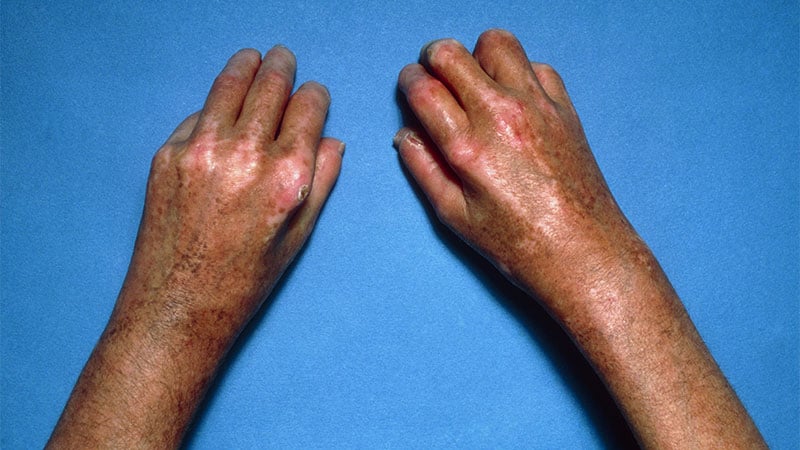Core Concepts
Patients with systemic sclerosis (SSc) and systemic lupus erythematosus (SLE) exhibit overlapping characteristics, emphasizing the need for recognition and monitoring of this syndrome.
Abstract
TOPLINE:
Patients with both SSc and SLE are more likely to be female, Black, and diagnosed with limited cutaneous SSc.
METHODOLOGY:
Used 2019 SLE classification criteria to identify patients with SSc meeting SLE criteria.
Study included 402 adults with SSc.
TAKEAWAY:
10% of SSc patients met 2019 EULAR/ACR Classification Criteria for SLE.
Patients with both conditions more likely to be female, Black, and have limited cutaneous SSc.
Anti-U1-RNP antibody positivity higher in SSc-SLE patients.
IN PRACTICE:
Clinicians should recognize SSc-SLE overlap syndrome and monitor for organ involvement.
SOURCE:
Study published by Ronald D. Bass, MD, MBA, of Georgetown University.
LIMITATIONS:
Study focused on Black vs. non-Black SSc patients, potential selection bias.
Overlapping patients may not represent true overlap of conditions.
DISCLOSURES:
No external funding sources or relevant financial relationships reported.
Lupus May Overlap in Many Patients With Systemic Sclerosis
Stats
Among the 402 patients with SSc analyzed, 10% met the 2019 EULAR/ACR Classification Criteria for SLE.
The prevalence of anti-U1-RNP antibody positivity was 30% in SSc-SLE patients and 6.6% in those with SSc only.
Quotes
"The results highlight the need for clinicians to recognize the SSc-SLE overlap syndrome."
"Patients with both SSc and SLE were significantly more likely to be female and Black."
Key Insights Distilled From
by Heidi Splete at www.medscape.com 09-15-2023
https://www.medscape.com/viewarticle/996500
Deeper Inquiries
What are the implications of the overlapping characteristics of SSc and SLE for treatment strategies?
The overlapping characteristics of systemic sclerosis (SSc) and systemic lupus erythematosus (SLE) have significant implications for treatment strategies. Since patients with both conditions exhibit a higher prevalence of limited cutaneous SSc and anti-U1-RNP antibody positivity, clinicians need to tailor treatment approaches to address both autoimmune diseases simultaneously. This may involve a multidisciplinary approach involving rheumatologists, dermatologists, and other specialists to manage the complex manifestations of both SSc and SLE. Additionally, the similarities in mortality rates and severe end-organ damage between the two groups suggest that treatment strategies should focus on early detection and aggressive management of complications to improve patient outcomes.
How might the potential selection bias in the study impact the generalizability of the findings?
The potential selection bias in the study, which was designed to compare Black to non-Black patients with SSc, could impact the generalizability of the findings. By focusing on a specific demographic group, the study may not accurately represent the broader population of patients with SSc and SLE overlap syndrome. This limitation could affect the external validity of the results and limit the applicability of the findings to more diverse patient populations. Clinicians and researchers should consider this potential bias when interpreting the study results and be cautious when applying the findings to patient care in populations with different demographic characteristics.
How can advancements in understanding overlap syndromes in autoimmune diseases influence broader medical research and treatment approaches?
Advancements in understanding overlap syndromes in autoimmune diseases, such as the overlap between SSc and SLE, can have a profound impact on broader medical research and treatment approaches. By recognizing and studying the complex interactions between different autoimmune conditions, researchers can uncover common pathogenic mechanisms and identify shared genetic, environmental, and immunological factors that contribute to disease development. This deeper understanding can lead to the development of targeted therapies that address multiple autoimmune diseases simultaneously, improving treatment outcomes and quality of life for patients with overlapping conditions. Additionally, insights gained from studying overlap syndromes can inform the development of personalized medicine approaches that take into account the unique characteristics of individual patients and their specific disease manifestations. This holistic approach to autoimmune disease management has the potential to revolutionize treatment strategies and improve patient care across a wide range of autoimmune conditions.
0
